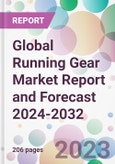According to the report, the global running gear market is projected to grow at a CAGR of 5.6% between 2024 and 2032 reaching a value of approximate USD 69.2 billion by 2032. Aided by the increasing global awareness of health and fitness and the rising popularity of running as a preferred form of exercise, the market is expected to grow significantly by 2032.
Running gear encompasses a wide range of products, including footwear, apparel, fitness trackers, and accessories, essential for enhancing the running experience. These products are designed to offer comfort, improve performance, and reduce injury risks for runners.
The global emphasis on health and wellness is a significant factor propelling the running gear market demand. As more individuals take up running to improve their physical fitness and mental well-being, the demand for specialised running gear continues to rise.
Innovations in running gear, particularly in footwear and wearable technology, play a crucial role in market growth. Advanced materials for better cushioning, support, and durability in running shoes, coupled with sophisticated fitness trackers, are enhancing the running experience for enthusiasts and professional athletes alike.
As per the running gear market analysis, there has been a notable increase in the number of running events and marathons worldwide, encouraging both casual and professional runners to invest in high-quality running gear. The growing trend towards outdoor activities and adventure sports is also contributing to the expansion of the market. The market also sees potential growth opportunities in e-commerce platforms, which have become a popular channel for purchasing running gear, providing convenience and a wide range of options for consumers.
North America currently leads the running gear market, attributed to its well-established running culture and high consumer spending on fitness-related products. Europe follows closely, with a strong focus on health and fitness. The Asia-Pacific region, however, is projected to experience the fastest growth. This is due to increasing health awareness, rising disposable incomes, and the growing popularity of running as a sport and recreational activity in emerging economies like China and India.
The future of the market looks promising, with opportunities for growth in emerging markets and advancements in product technology. Sustainable and eco-friendly running gear is expected to gain popularity as consumers become more environmentally conscious, which further boosts the running gear market growth.
Running gear encompasses a wide range of products, including footwear, apparel, fitness trackers, and accessories, essential for enhancing the running experience. These products are designed to offer comfort, improve performance, and reduce injury risks for runners.
The global emphasis on health and wellness is a significant factor propelling the running gear market demand. As more individuals take up running to improve their physical fitness and mental well-being, the demand for specialised running gear continues to rise.
Innovations in running gear, particularly in footwear and wearable technology, play a crucial role in market growth. Advanced materials for better cushioning, support, and durability in running shoes, coupled with sophisticated fitness trackers, are enhancing the running experience for enthusiasts and professional athletes alike.
As per the running gear market analysis, there has been a notable increase in the number of running events and marathons worldwide, encouraging both casual and professional runners to invest in high-quality running gear. The growing trend towards outdoor activities and adventure sports is also contributing to the expansion of the market. The market also sees potential growth opportunities in e-commerce platforms, which have become a popular channel for purchasing running gear, providing convenience and a wide range of options for consumers.
North America currently leads the running gear market, attributed to its well-established running culture and high consumer spending on fitness-related products. Europe follows closely, with a strong focus on health and fitness. The Asia-Pacific region, however, is projected to experience the fastest growth. This is due to increasing health awareness, rising disposable incomes, and the growing popularity of running as a sport and recreational activity in emerging economies like China and India.
The future of the market looks promising, with opportunities for growth in emerging markets and advancements in product technology. Sustainable and eco-friendly running gear is expected to gain popularity as consumers become more environmentally conscious, which further boosts the running gear market growth.
Market Segmentation
The market can be divided based on product, gender, distribution channel, and region.Market Breakup by Product
- Running Footwear
- Running Apparel
- Running Accessories
- Fitness Trackers
Market Breakup by Gender
- Male
- Female
- Unisex
Market Breakup by Distribution Channel
- Supermarkets and Hypermarkets
- Department and Discount Stores
- Speciality and Sports Shops
- Online
- Others
Market Breakup by Region
- North America
- Europe
- Asia Pacific
- Latin America
- Middle East and Africa
Competitive Landscape
The report looks into the market shares, plant turnarounds, capacities, investments, and mergers and acquisitions, among other major developments, of the leading companies operating in the global running gear market. Some of the major players explored in the report are as follows:- Adidas AG
- ASICS
- Nike
- Skechers USA, Inc.
- Columbia Sportswear Company
- Others
Table of Contents
1 Preface2 Report Coverage - Key Segmentation and Scope4 Key Assumptions7 Opportunities and Challenges in the Market15 Value Chain Analysis17 Key Trends and Developments in the Market
3 Report Description
5 Executive Summary
6 Snapshot
8 Global Running Gear Market Analysis
9 North America Running Gear Market Analysis
10 Europe Running Gear Market Analysis
11 Asia Pacific Running Gear Market Analysis
12 Latin America Running Gear Market Analysis
13 Middle East and Africa Running Gear Market Analysis
14 Market Dynamics
16 Competitive Landscape
List of Key Figures and Tables
Companies Mentioned
- Adidas AG
- ASICS
- Nike
- Skechers USA Inc.
- Columbia Sportswear Company
Methodology

LOADING...








